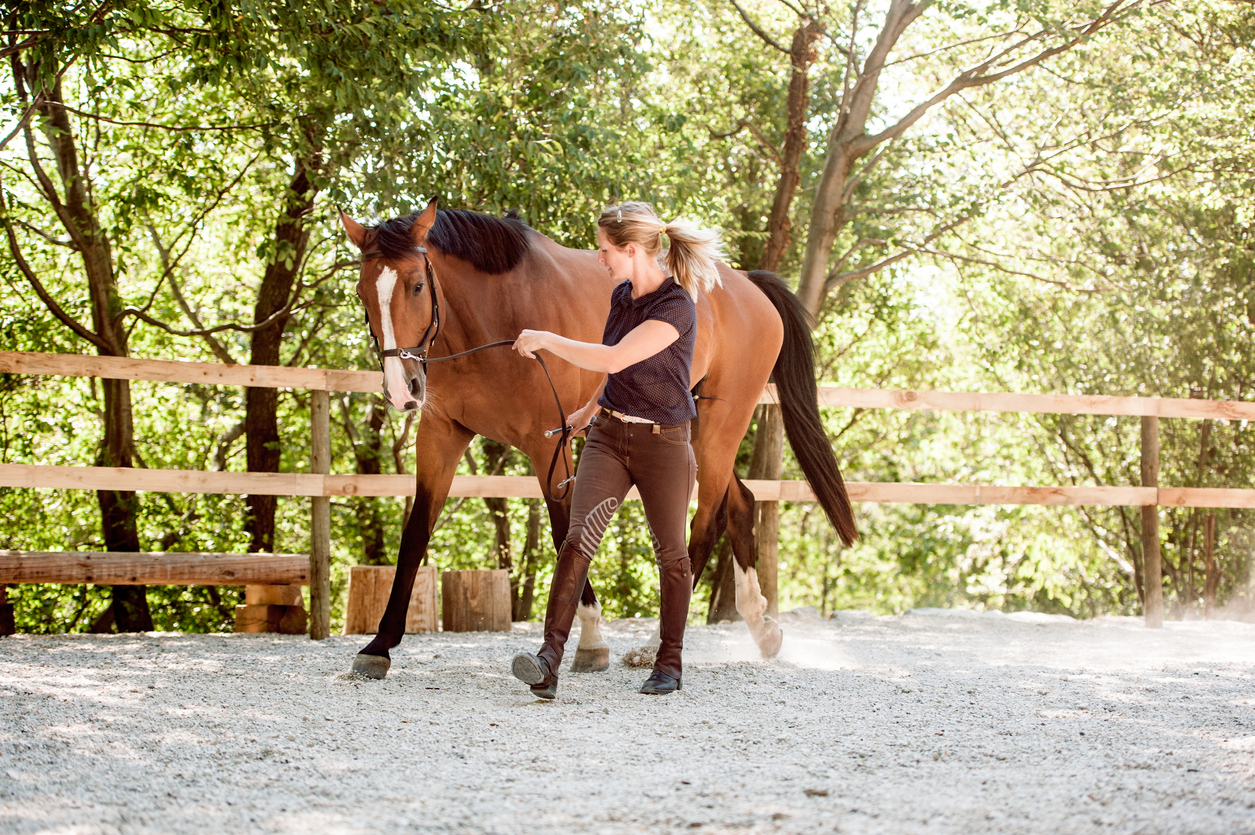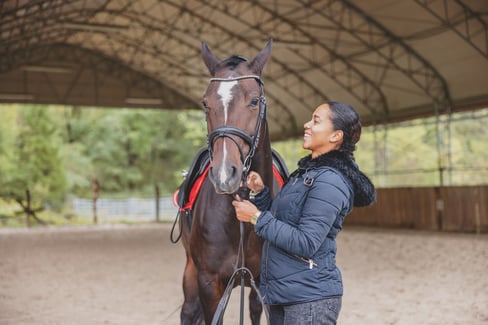Table of Contents
Jumping in the saddle, holding the reins in your hands, and galloping off into the distance on your best friend’s back? There’s nothing like it in the world.
Riding your horse doesn’t just benefit your majestic steed, it’s also good for you. Riding gets you out into nature, helps you relax and bond with your horse, and can even help you burn calories.
But we can’t always ride our horses. Sometimes, injuries you or your horse have sustained can prevent regular rides. Also, riding your horse too much is not a great idea, as it can be a strenuous activity, and they can get overworked, which can result in an injury.
Prioritizing different types of horse exercise is the best way to keep them healthy and happy physically and mentally while reducing the risk of injuries as much as possible.
In this article, we’ll go through different recommendations and tips for horse exercise and conditioning, including how to put together a conditioning program for your equine.
Is It Important to Exercise Horses?
You should always exercise your horse, of course! Horses are built to move. As natural athletes, they should be given ample opportunity to roam and exercise their powerful muscles to maintain their health.
If your horse is in a paddock with good pasture, they will exercise themselves as they move around to graze. With other horses, they’ll naturally run, jump, and play. Horses that are kept in stables should be turned out daily onto pasture, preferably with other horses, so that they can move around and be social with the other animals.
Horses turned out alone are more likely to stand around rather than graze. This is because horses are herd animals and enjoy being close to each other.
Why Is a Horse Exercise Routine Important?
Aside from general horsing around, having a horse exercise program is important for general horse health. Horses are also creatures of habit; they LOVE routine. If a horse is used to getting fed at 6:00 a.m. and one day doesn’t get fed until 8:00 a.m., they will likely get anxiou
Horses have a deep seeded instinct to choose flight over fight in dicey situations. This means that no matter what’s happening around them, this instinct will pop up when necessary. A solid daily routine can help calm the horse and give them the security they need to feel relaxed. As herd animals, horses view you as an essential part of their pack. Exercise should fit seamlessly alongside daily food, water, and grooming sessions.
A daily horse exercise program has the following benefits:
- Improves functioning of internal systems, like the heart, lungs, and digestive tract
- Increases their stamina and endurance over time, helps develop muscles, and strengthens tendons and ligaments
- Helps with proper bone and hoof development, which is essential for reducing lame horse risk
- Makes your horse stronger, increasing their resistance to disease by boosting their immune system
- Helps prevent behavioral issues associated with prolonged confinement
- Helps keep your horse alert and helps with quicker reflexes and overall coordination
While horse exercise is important and provides many benefits, it’s also important to not overwork your horse.
How Much Exercise Does a Horse Need?
Before you hit the gym with your horse, you need to understand their physical condition and develop an exercise plan that meets their current fitness level. If your horse isn’t used to much physical activity, you must be patient and gradually work up to a higher level. The goal is to get to an exercise routine that will maintain or improve your horse’s fitness level.
In general, the elements of a daily horse exercise routine should include the following:
- Warming up: Before getting into the full exercise routine, you should warm up your horse with light activity. A basic warm-up should include a 10-minute active walk on a long rein. This will reduce the chance of injuries
- Stretching or suppling exercises: A regular stretching routine helps prevent injuries and helps strengthen pathways between nerve endings in your horse’s muscles, tendons, ligaments, and joints, giving your horse’s brain more information about body movement and limb position. This strengthens your horse’s suppleness and elasticity and works to reduce the chances of pulled muscles or tendons. Further, stretching and suppling exercise improves circulation, helps to relieve pain and inflammation, and reduces muscle spasms.
- The exercise routine: In addition to stretching and warmup exercises, an exercise routine can be established. A typical horse can be turned out to pasture and exercise through grazing and interaction with other horses, but a sport horse or race horse would need an established and consistent exercise routine with their trainers. Horses that are pastured and free to move during the day may only need around 15-20 mins of exercise, while horses that have been stabled for longer periods may need 30 mins to an hour of exercise.
- Cool down: After exercise, it’s important that your horse gets time to cool down, especially if the exercise routine is more strenuous. Drying off your horse (they sweat, too!) and giving them time to get their body temperature back to normal is essential.
Of course, you’ll likely be riding your horse regularly as well, which also counts as horse exercise. Before riding, it’s important to warm up your horse and stretch them a bit to prepare them for your adventure together.
How to Exercise a Horse?
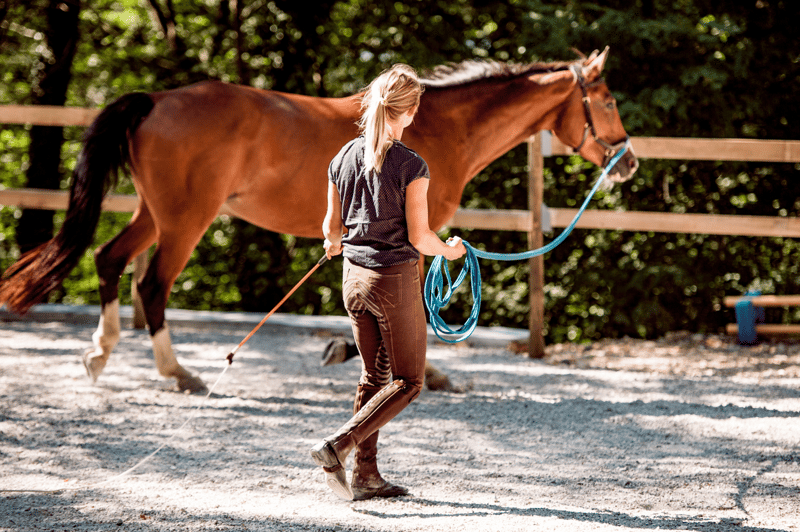
Saddling up isn’t the only way you can exercise your horse. There are a variety of ways you can interact with your horse and provide them with the activity they need, including:
1. In-hand Walking
Simply walking alongside your horse as they gently walk forward is called in-hand walking. Even though it’s simple, in-hand work is a great way to bond with your horse, provide exercise to a horse recovering from an injury, or exercise an old horse. By supporting your horse from the ground, you can also help them gain confidence with in-hand walking by helping them navigate different situations without a rider on top of them. For instance, your horse might be hesitant to cross a small, shallow creek with you on top of them, but in-hand walking can help them build up the confidence they need to cross so that next time you’re riding them, they can cross easily.
2. Ride and Lead (Ponying)
If you need to exercise two horses at a time, ride and lead, or ponying, is an effective method. You’ll only want to attempt a ride and lead if the horses are comfortable with each other, like paddock mates. You don’t want them fighting, biting, or kicking each other during your ride. You should have good control over the horse that you’re riding because you’ll need to handle them with one hand on the reins.
Now that those two basics are explained, here are some more tips for effective ride and lead:
- The horse you’re leading should be led off your left side. This way, the horse is in between you and the fence line. If the lead horse gets spooked and tries to swing its hindquarters outward, it will be blocked by you and the horse you are riding. Practicing first in a safe area is a good idea before taking them out next to a busy road, for example.
- You should lead with a bridle, but sometimes younger horses can get uncomfortable with the pressure on the bit, so you may have to start with a halter, at least initially. Then of course, you will want to use a lead rope.
- Make sure your horse’s stirrups and girth is tight and correctly positioned because you don’t want to have to fiddle with these items once you’re mounted on the horse.
- To mount, it’s best to have someone to help, but if you’re by yourself, give everyone a lot of space. Hold the reins in your left hand while you’re mounting the horse and then transfer reins to the right hand.
3. Lungeing Your Horse
Lungeing is a useful training exercise when time and space are limited or if a horse needs to exercise without a rider. It involves the horse moving in a large circle around the handler, with the handler attached to the horse via a long rein known as the lunge line. The basics of lungeing are easy for beginners, but the real skill is determining if the horse is being worked optimally. This skill requires time to develop.
Lungeing can be essential in rehabilitating a horse from physiological issues like kissing spine or pain in the joint surface regions, but it needs to be done properly to avoid further injury. Always consult with a vet before lungeing a horse with injuries to ensure it’s a safe exercise.
4. Long Reining
Before a young, unbroken horse can be ridden, they need to go through different exercises that help prepare them for the weight of a rider and understand the commands that a rider would issue to them. Long reining is sometimes recommended over lungeing to start, but some people recommend doing lungeing first. Your decision should be made alongside an expert and with an understanding of your horse’s unique personality and temperament.
While long reining can be used in the training process of a young horse, it can also help older horses alleviate some problems they may have developed with riding over time.
Aside from having a helper to work with you, here are the general steps for long reining:
- The handler stands behind the horse with a lunge line in each hand, similar to a set of reins. One lunge line should be attached to the nearside bit ring, while the other lunge line is attached to the offside bit ring and threaded through the offside stirrup or a loop in thesurcingle. Your helper can help with this process.
- The second lunge line should be passed onto the horse’s side so it runs behind the saddle orsurcingle and alongside the offside hind led. If your horse is distressed by the feel of the lunge line on their side, simply have your helper lift the lunge rein away from the horse and patiently repeat the process until your horse relaxes and gets used to the feel of the lunge line.
- Stand on the horse’s left side, and rest the second lunge line over your horse’s croup. Ask your horse to walk forward while at the same time allowing the rein to drop over the croup and end up behind the horse.
Sessions should be kept short, around 10 minutes or so, with gradual increases until sessions end up being about a half-hour long.
5. Free or Loose Schooling
As an alternative to lungeing or long reining, loose schooling, or free schooling, a horse is a great way to warm up your horse in preparation for exercise, play with them, and also develop your emotional and body language connections with your horse. Essentially, you’re using your hands, eye contact, and movements to tell the horse what you want them to do. For example, raising your hand in front of their field of vision prompts your horse to change direction and change your rhythm with your horse to get them to trot or canter. Throughout the process, you’ll want to keep a distance from your horse for safety reasons, just in case they kick or get excited.
6. In-hand Agility
Horse agility aims for the handler to navigate their horse, with or without a rein, through different obstacles. It’s an equestrian sport that focuses on clear communication between handler and horse and is a fun, positive way to build trust. Aside from providing the horse with exercise, horse training in agility also helps the handler develop their horsemanship, communication, and timing skills with their horse.
Is a Horse Conditioning Schedule Recommended?
Remember how we mentioned that horses are athletes? Implementing an equine conditioning schedule is recommended if you’re training your horse to participate in a sport or preparing them for daily work.
Even if you’re not planning on participating in sporting events or using your horse for work, conditioning your horse helps you develop a relationship with them and gives you insight into their strength and fitness.
Different horse conditioning routines that you can consider are outlined in the table below.
|
Horse exercise routine |
Benefit |
|
Cardiorespiratory |
Improves the heart, lungs, and muscles |
|
Strength |
Increases the endurance and power of muscles |
|
Suppling |
Reduces risk of injury through stretching of joints and muscles |
|
Anaerobic exercise |
Comprised of activities that cause the heart and respiration rates of your horse to increase |
|
Aerobic exercise |
High-intensity activities that help develop the muscle’s ability to store oxygen to feed these activities |
Horse Conditioning Tips
One of the most important things to remember with horse conditioning is that it should be gradual. Rushing your horse into strenuous exercise too soon can result in injuries or a general distaste for what you’re trying to get them to do.
To condition your horse properly and avoid potential injuries, follow these tips:
- Be sure your saddle fits properly. Check your saddle fit weekly as you’re conditioning your horse, as their body will change.
- Take advantage of longer walking sessions. Walking, especially forward walking, is a low-impact activity that helps with your horse’s fitness. It also allows you to work on your horse’s responsiveness and build a stronger bond with your horse.
- Hills can help build strength. Hills are especially helpful for building your horse’s hind end. If you’re just starting with hill work, it’s essential to take a gradual approach to avoid injury to your horse, even if you’re just using small hills initially. Start by introducing hills during walk and trot, and only do a few up and down repetitions. Over time you can start adding steeper hills, introduce cantering, and longer sessions.
- Time your rides. It’s easy to lose track of time when you’re out riding your horse, but with fitness training, it’s essential to time your rides to ensure consistency and allow you to gauge whether you should increase or decrease conditioning sessions. You can even use horse fitness tracking apps to time rides and track your horse’s conditioning progress.
- Listen to your horse. If you’re doing too much too fast, or your horse can handle a little more, they will let you know. Making sure you’re listening to your horse’s body language, like if they are suddenly short-strided, shifting their weight from one side to another, reluctant to follow directions, or otherwise showing signs of discomfort. These signs could indicate an injury or just be letting you know it’s time for a break. You may even have to halt the conditioning for a few days to give your horse time to recover.
The Importance of Getting a Horse in Shape
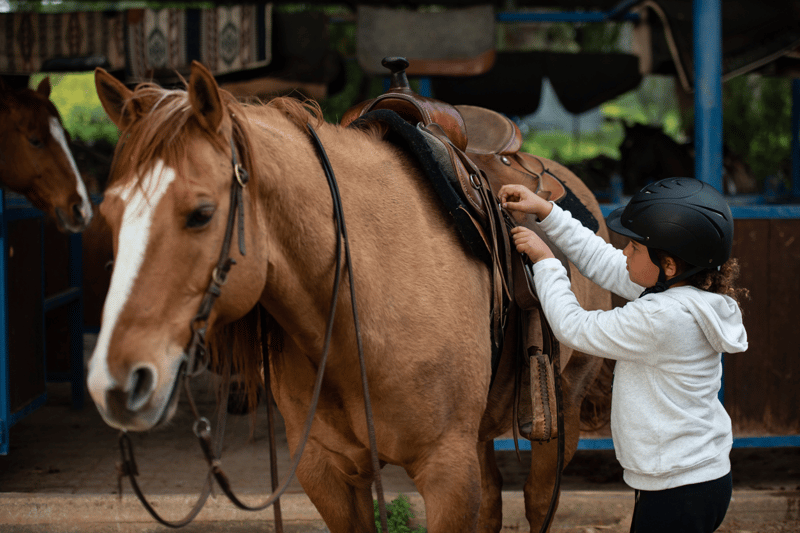
Just like humans, horses benefit significantly from being in good physical and mental shape. Regular exercise helps keep bones and hooves strong, develops muscle and strengthens ligaments, and keeps internal systems working correctly—including the lungs, heart, and digestive system.
The longer a horse is inactive, the harder it will be for them to move freely, eat and drink without discomfort, and fight diseases.
The Importance of Getting an Older Horse Back in Shape
As horses age, exercise becomes even more critical for ensuring they stay happy and healthy. Just like young horses, exercise helps senior horses with their bones and internal systems and also helps them fight diseases. But more importantly, regular exercise for senior horses helps them live longer and be healthier and more comfortable during their golden years.
Of course, a horse exercise routine for a senior horse should include more low-key activity, like walking and long-reining. The importance of warm-up and cool-down is also even more important for senior horses to ensure that their muscles, joints, and ligaments don’t experience any unneeded extra stress.
One of the ways you can ensure that your horse has strong, healthy joints as they age is by adding horse supplements to their diet. TRI-ACTA for equine is an excellent choice for horses of all ages as a joint supplement that provides the essential building blocks that your horse needs to maintain healthy joints without any fillers or additives. This means a simple 20g daily serving is all your horse needs.
For equines that have experienced or are experiencing joint injuries, TRI-ACTA H.A. for equine boosts recovery by including hyaluronic acid, an essential component that adds further lubrication to aching joints.
TRI-ACTA H.A. for Equine
Our maximum strength formula is perfect for horses that are ageing, experiencing arthritis and stiffness, are in training and competition, or under a heavy workload.
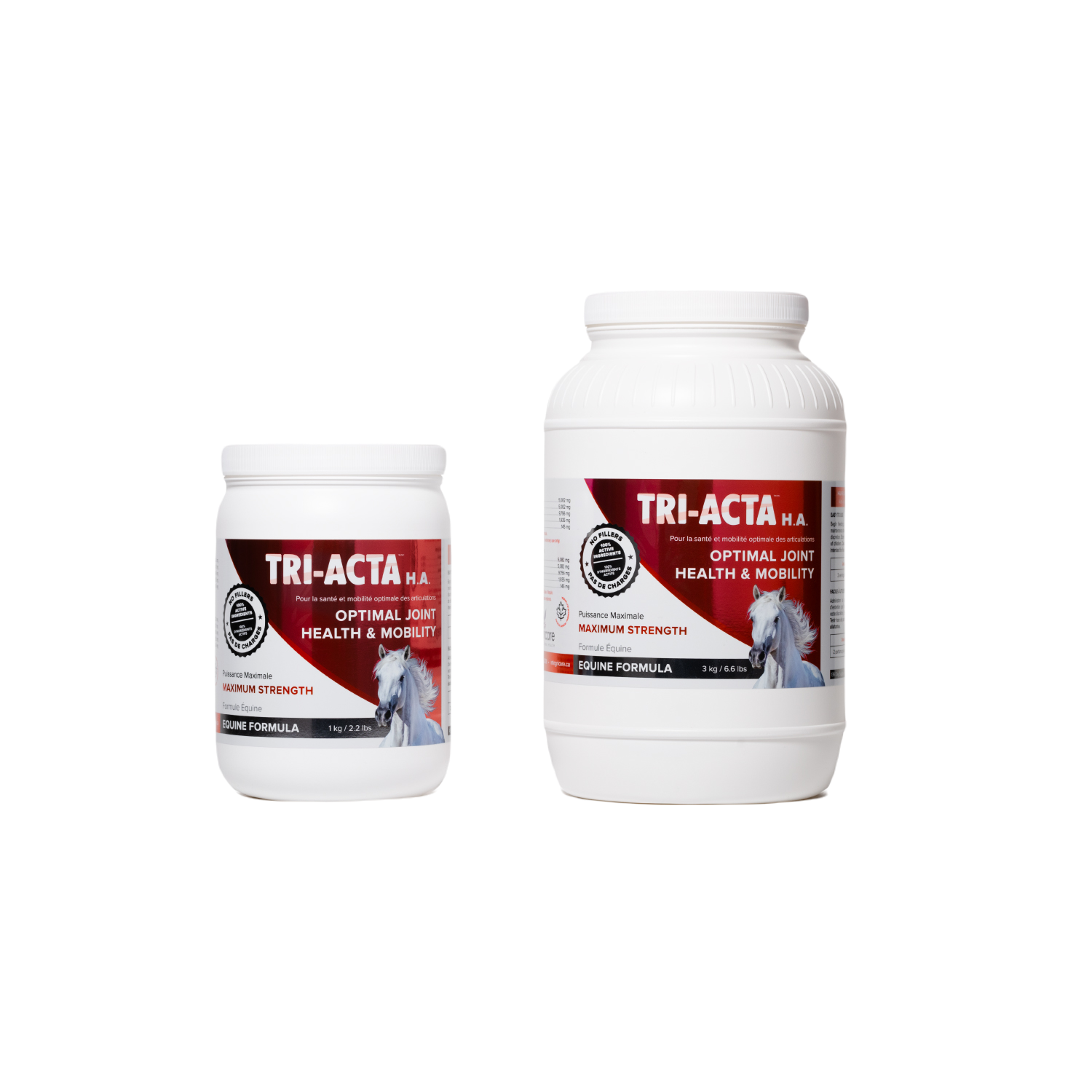
How to Put Together an Effective Equine Conditioning Program?
Creating an effective equine conditioning program depends on the horse themselves and what activities they are set to participate in. A pasture horse will likely need a simple exercise plan, while a sport horse will need something more robust. In any case, the best way to get your horse to their optimal fitness level is to develop a consistent plan that you can ease into their daily routine.
Horse Exercise Routine for the Average Horse
Keeping their exercise routine simple, short, and straightforward for the average horse can be beneficial. Here is a sample routine from Cowgirl Magazine:
|
Time period |
Instructions |
|
Week 1 |
Walk your horse for 25 minutes, then once they are warmed up, see if you can get them to trot for 5 minutes. |
|
Week 2 |
Walk your horse for 25 minutes and trot for 10 minutes. |
|
Week 3 |
Do a 35-minute riding session with your horse, with 15 minutes of trotting. |
|
Week 4 |
Ride for 35-40 minutes and include 15 minutes of trotting and 5 minutes of loping/cantering. |
|
Week 5 |
40 minutes of riding, which includes 20 minutes of trotting and 10 minutes of loping/cantering. |
|
Week 6 |
Increase rides up to 45 minutes with a mix of trotting and loping/cantering. |
Equine Conditioning Program for Eventing
Developing a conditioning plan for an eventing horse is a bit more complex, but if you’ve started with the above program for an average horse, you should be able to slowly build your horse up to be able to canter for a total of 12 minutes, including three sets of four minutes each.
It’s crucial that when you are conditioning your horse, you’re using an area that’s suitable for this type of training, and the ground isn’t too soft or too hard.
- If you can go out into the field and kick your heel into the grass, that should indicate that the ground is soft enough yet stable enough for your horse to train on.
- If you’re training in an arena, the rock-hard ground can potentially cause injury, so it’s essential to adjust the training as needed to not be too hard on your horse.
Summary
Horse exercise is just as important as human exercise. Because we are our horse’s caretakers, we ensure our horses are happy, healthy, and in good shape. Food, water, and shelter may be the first things you think of when listing the basics for horse care, but exercise is also essential.
Check out TRI-ACTA for equine to help maintain your horse’s joints during conditioning or regular exercise.
TRI-ACTA for Equine
Providing preventative support for younger horses and helping mitigate the early onset of joint degeneration and other mobility issues.
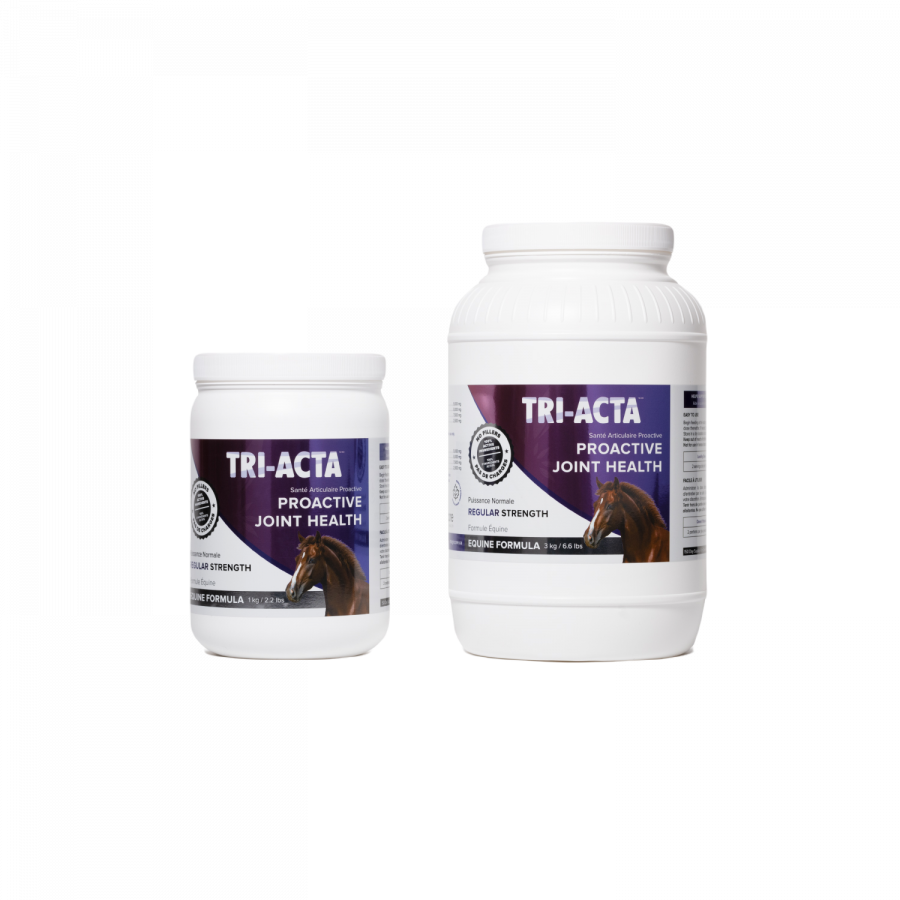
Newsletter Signup
Subscribe to our newsletter to receive the latest news and exclusive offers.
.jpg?height=2000&name=Cliick_Integricare-DISPLAY-REVISEDV2%20(1).jpg)
Proactive & Therapeutic Joint Supplements
When given daily, Integricare joint supplements recover bone and joint injuries faster and help prevent mobility injuries from happening in the first place.

